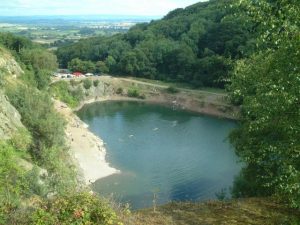Hydrogeology of the Malvern Hills
The Malvern Hills lie predominately within the River Severn catchment area. Average rainfall ranges from 650mm in the lower elevation area of the Severn valley to over 700mm to the west of Great Malvern.
The presence of the many fault springs has determined the positions of the various villages, which now make up the Malverns. The majority of the smaller villages, with the exception of Great Malvern, were dependent upon water provided by shallow springs and wells. Consequently villages began to develop in the vicinity of the fault springs. Such was the origin of Malvern Wells, West Malvern, Upper Colwall, Lower Wyche and Barnard’s Green.
Public supplies to the Malvern villages were generally obtained from springs, and capture trenches. The narrow, steep sided and linear nature of the Malvern ridge means that the catchment area is extremely small. Therefore, the discharge or flow rate of some of the springs and spouts does vary considerably. This is more noticeable during dry periods when groundwater recharge is low or absent. This means that the availability of water in some springs can be inadequate to meet public demand.
The groundwater is recharged directly through the infiltration of water derived from rain and snow falling onto the Malvern Hills. The igneous rocks of the Malverns Complex have a low primary porosity and permeability. Therefore the movement of water through the Precambrian rocks is reliant upon the presence of fissures and faults. The long complicated geological history of the Malvern Hills and the various tectonic events, which have shaped the area have resulted in a well developed fissure or fault network throughout the Precambrian rocks. Consequently the Malverns Complex has a high secondary permeability via fissure flow. The fissured rocks are locally weathered and crushed. Water collects in the fissures and gradually works its way down until it reaches the less permeable sedimentary rocks where it emerges and overflows as springs.
There are a number of district hydrological boundaries within the Malvern Hills. The most apparent boundaries coincide with the junction between the Malverns Complex and the Eastern and Western boundary faults . Significant springs associated with the Western Boundary fault are formed where Silurian and Cambrian rocks lie adjacent to the Precambrian . These geological boundaries either represent a faulted contact or an unconformity. Pewtriss Well is one of the most important springs issuing from the Western Boundary fault. Excavations at the spring in 1928 revealed that Silurian Wenlock shales are faulted against the Malverns Complex. Other springs, which are fed by water emerging from the Western boundary fault include Hayslad spring, Wyche Spout, Willow Spring, Walm’s Well, Wynds Point and Royal Well spring.
A number of smaller faults cut across the Malvern Ridge. These cross faults or transverse faults also provide a pathway for groundwater to reach the surface to form a spring when they coincide with the Western Boundary Fault. The cross faults forming small valleys at Wyche Cutting, Wynds Point and Hollybush represent important hydrological boundaries with the fault systems. Whereby, the faults have effectively separated the Hills into several different independent flow regimes. For example, the Genwood Spring lies on a well-defined fault line, which passes through Eye Well .
The eastern boundary of the Malvern ridge is marked by the Eastern Boundary Fault. This is a major fault, which throws the Triassic strata down to the east and its throw varies between 2600 – 2300 m . The faulted boundary between the Precambrian and the Triassic is also an important hydrological boundary. Springs issuing from the base of the Eastern boundary fault include Clock Tower, Weaver’s Well and the Bottling Works Spring . The Triassic rocks adjacent to the eastern boundary fault also provide a good aquifer and many springs can be found within the permeable Triassic sandstones underlying the West Malvern area .
Springs also emerge directly from the fissures within the Malverns Complex. St Ann’s Well (SO775 4578) and Holy Well (SO77064231) issue from fissures in the Malverns complex and this spring water does not come into contact with any other geological strata. These rocks have a low solubility and therefore the rocks are reputed to be of exceptional purity and softness, due to their relatively low dissolved mineral content, whereas the springs allocated at the margins of the Malverns Complex tend to contain an increased mineral content. For example water emerging at the junction between the Silurian rocks tend to be harder and contain some dissolved solids in the form of the mineral calcium carbonate.
Despite the low permeability of the sedimentary rocks adjacent to the Malvern ridge, some springs emerge directly from the Silurian and the Cambrian rocks. Although groundwater movement is largely facilitated by the presence of faults and fissures contained within these sedimentary rocks. For example, the Silurian sandstones of the May Hill Sandstone Formation are relatively permeable and to the west of the of the boundary fault some water makes its way from the boundary fault and travels through the permeable sandstones to form small springs. Examples include, Beacon Spring. Although the Silurian Shales (Lower Ludlow Shales) is a relatively poor aquifer due to its low permeability, some springs are able to emerge from fissures and joints contained within them. For example, the source of supply of the Chances Pitch spout is from a spring, which emerges from a fault within the Lower Ludlow Shales.
